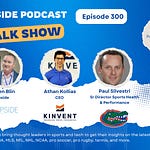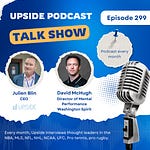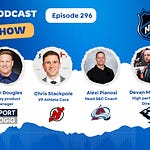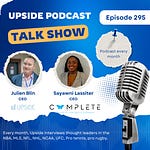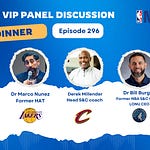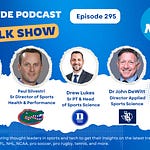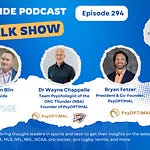This week, we have the honor to interview Kevin Martin, CEO of The Quick Board, that developed a visual training and rehab technology.
Founded in 2009, The Quick Board is the only training and rehab technology scientifically proven to significantly improve agility. It is designed to elevate human performance by enhancing motor learning with real-time feedback during exercises. It also can highlight and restore injury deficits by addressing the neurological aspect of injury.
Picture: The Quick Board
The Quick Board’s software allows athletic trainers and physical therapists to customize exercise protocols based on their clients' weaknesses and injuries. These exercises are designed to improve user reaction times, speed, stability, coordination, balance, and proprioception. Our visual-motor technology keeps the user focused on their movement results during exercises, while the iPad displays real-time feedback, which increases the likelihood of transfer to sports and everyday tasks. This allows Quick Board users to see objective and measurable progress in patients returning to sport and athletes improving their performance.
Here is a video explaining how the Quick Board works:
The Quick Board is currently being used by half of NBA teams (NY Knicks, Minnesota Timberwolves, Houston Rockets, Cleveland Cavs, Denver Nuggets..), a quarter of the NFL teams, Johns Hopkins, and other top healthcare institutions.
📝Show Notes: Through this interview, we touched on his background, his role, his company and product, the benefits for sports organizations to use his product. We also talked about his plans for the next 12 months.
🚀Best Quotes: Here’s some of the key discussion points and best quotes from our conversation with Kevin:
On his background in performance training:
“So I am from Memphis, Tennessee, which I'm sure you may be able to tell (..) I grew up here throughout my childhood, then I went to Auburn University down in Alabama, not Georgia. I actually played lacrosse down there. And I gained my passion for performance training because I would come back to Memphis in the summertime, rather than staying in Auburn”.
“And there was a renowned performance coach here in Memphis. He actually used to be the strength coach at the University of Memphis. He worked with athletes like Isaac Bruce, Penny Hardaway, many others. His name is Dean Lotz. He opened up his own private facility. And so I started training with him, and I became good friend with his son, Beau Lotz, who actually has a facility in Buckhead, right there in the Atlanta area now, at the Buckhead Elite training studio”.
“The impact that Dean had on my performance in Lacrosse, especially after the first summer that I trained with him. It was pretty profound and it made an impact on me. It made me a better player. And so that's where I gained my passion for performance training”.
On how he got the idea of launching his company The Quick Board:
“Dean developed his own methodology. Once I completed my time at Auburn, I wanted to learn more about his methodology. So I started working for him at his facility after college and he had a concept room with some experimental type of training equipment. And one of those devices was, what is now known as The Quick Board. But it was essentially then a concept training device”.
“And so I became a performance coach. Unfortunately Dean passed away. He was a NFL veteran, and so that was a number of years ago. And so I went out on my own and trained athletes and then at that point in time, I knew there was a need for that device that I had trained on and I wanted to bring it to the market, and make it available for athletes and coaches”.
On how The Quick Board works:
“So it is considered a visual motor training technology. It consists of an iPad software. Athletes are focused on looking at an iPad and they're standing on a high-impact sensor board, so we're sending real-time movement data to the iPad software, and they're able to see that in real time”.
“And the benefit with that is, in what Motor Learning Research teaches, you want to be focused on the outcome of your movement, not the movement itself because when you think about it, whether it's everyday life or in sports, it's often the case. Your eyes are up. You are looking straight ahead, taking in the environment, all that information is being processed through the eyes of the brain and then sending that information or commands to arms and legs”.
“And we're trying to replicate that and, it's the sensor board itself. We have seven central locations in it. The layout is just kind of envision, it looks like five on a dye. It's got two dots, up top. One in the middle, and then two at the bottom. And so it's a functional layout, similar or same thing as the old dot drill mat, which people are familiar with, except now that what we're doing is we're really enhancing the training benefit by providing you real-time feedback and objective data for all of the tests and exercises that you're performing”.
On how teams and athletes typically use The Quick Board from testing, training to rehab:
“It really depends on the team and the system that they have in place. Everybody has their use case. One instance is that we actually have a two sensor board. So it only has two sensors on it, and some teams actually travel with that and they use that to track the players’ performance on what we call foot fire, which is essentially explosive quickness”.
“And one of the teams, one of the strength coaches actually found a significant correlation to vertical jump. So it's in some ways monitoring that without having those players jump and they do enough jumping throughout the season. So they're able to monitor preparedness and what they look like, game to game, and at the same time get that nervous system firing”.
“So they have the players perform a few rounds of the foot fire, five seconds. So there's no fatigue. We have a ten second versions and a longer one, but the five seconds really reduces the work required and they're able to get some good data off of that”.
“So it is being used for preparedness, testing, and for draft picks coming through. They like to see what they look like from that potentiation standpoint and how explosive they are. And it's a very simple pattern. It's not a complex movement, which entails technique so they test them on foot fire. Also we have some of our reaction exercises, which is single color, which is when it lights up. You respond to the corresponding sensor, the sensor board. And then there's neurocognitive reaction that we have in there. And we have a couple different capabilities for neurocognitive”.
“Most commonly, the testing and training is how they like to implement it, but then some teams are using it for rehab as well”.
On who in NBA and NFL teams typically use the Quick Board with players:
“On the NBA side, the strength coaches and some of the staffs use it. And it floats over to that athletic training room. But like anything else, everybody has technologies, right? And it's all about time. So on the NBA side, it would be more strength coaches. In the NFL it's a numbers game. You've got a lot of guys that you're trying to get in there to complete their workout for the day”.
“So it can be a little more challenging for those larger team sizes. So on that end, you're seeing it more on the sports medicine side, rehabilitation baseline. But in terms of teams with less players than an American football team, and they are using it, mostly on the training side”.
On what teams like the most about The Quick Board such as the library of exercises and pre-programmed protocols:
“I think the important thing with any technology that we get feedback on, is time efficiency And that's one thing that I've tried to dial in with my experience in training athletes. Time is a huge limitation, especially with technology. You can have the best technology in the world, but you don't have all the time in the world. So time efficiency, having a technology that when you introduce it, it's actually going to function as a staff member and provide value on the data side”.
“That's why we have not only a library of exercises, anything from reaction, neuro cognitive reactions, speed, speed, quickness, coordination. We have single leg hops. So the list goes on, but to help make sense of that and how to implement it is we have a whole section in the app that already has pre-programmed protocols”.
“So anywhere from rehab protocols for ACL, but then also training protocols. And in terms of time efficiency, the way we try to improve that, beyond just protocols is with the agility rating, after an athlete performs an agility rating. Then our software actually recommends which workout they need to perform”.
“So motivating, keeping them goal oriented, constantly pushing them to achieve their best. That's what I would say, that teams, not only do they like the unique aspect, the eye foot benefit. and the data points they get there, but the ease and time efficiency of actually implementing it on a daily or weekly basis”.
On their competitive advantage such as their long tenure in the market, their focus on getting continued feedback from customers to improve the product:
“I would say that's one thing we've worked with universities in dialing in that methodology. We have published research showing that training on The Quick Board has significantly improved laser time, whole body change of direction, and also balance. And we're continually having Thee Quick Board in studies to prove that, especially on the rehabilitation side”.
“But in terms of competitive advantages, it's the time that The Quick Board has been on the market. I launched this company back in 2009 where I brought it to market. So the length of time that Quick Board has been on the market is one of our competitive advantages. We've really dialed in the sensor, board design and manufacturing process. There's no weight limit on the sensor board”.
“And we also, as we discuss with the automation and the agility rating, is we listen to the needs of the market. And so that drives our continual investment, and new capabilities and software improvements. So it's like anything else. You think you know best, based on research and what that's telling us, but at the same time you need to talk to your customers and see what's working for them”.
“And of course time is a very important factor. And so the automation and progress reporting and agility rating report, those have all been developed over time based on the market need and what teams have expressed to us what they're looking for”.
On their business model (hardware, software):
“We have a hardware component, which is the sensor board, and we have two different sensor boards, and we have the HD sensor board, which is a smaller size sensor board, so it's 41 inches by 31 inches, and they're about a half an inch thick, so they're not excessively tall”.
“And then we have an HD Pro Sensor board, which is 47 inches, about 37 inches. And that of course is more for more elite athletes high school, college pro. And the price range, the HD board is $2,200 and the HD PRO is $2,400. And then they're made in the US”.
“And then in addition to the sensor board cost, we have a software subscription. Due to the nature of the cost to pain and continually improve the software, it's something that we had to do, but it provides a better technology to the end user”.
“And the subscription costs range between $100 to $200 a month. And it depends on how many athletes you have. And then we also have requirements for instance on the enterprise side where we work with large physical therapy networks. And they have more demands in terms of HIPAA and security and that sort of thing”.
On their great device replacement policy and warranty:
“For example if somebody kicks the charger, or anything like that, it is covered. We just ship a new charger. No questions asked. So it's essentially better than AppleCare in that sense. There's no fee for a replacement part because in the end we want our customers to stay up and going and it doesn't do anyone any good to be down and going back and forth”.
On his plans for the next 12 months:
“We’ve been fortunate enough where our sales are doing well. Cash is king. So sales have been able to help us get to this point. But we are always open to hearing from strategic investors and partners. On that front, because like anything else, it can speed everything up, right? And so that's always an option in my mind”.
“We do have some new technologies that we're working on. So we have a couple projects that I don't quite want to mention because there is some lead time in there, but it's something that is complimentary to what we're currently doing”.
“In addition to those sort of projects, we have some studies that we have coming up. We have, for instance, a university conducting a study on the effects of cognitive dual task on neo valgus. And so that's being used with our neurocognitive reaction stability exercises where you're stabilizing on one leg, reacting with the other. So that's one study that we actually have going on right now”.
“We have a vertical jump validation study that should be published later this year, and it compared The Quick Board, vertical jump, versus motion capture. And we had really good results. So we're excited about that”.
“And then with the agility rating, we have one facility, physical therapy clinic where they've seen a correlation between the agility rating and force plate data. And so that's going to be a study that we're going to get started up later this year and also we are beginning a larger scale ACL study. And they're finding that compared to match controls, with The Quick Board, athletes or patients are meeting return to sport criteria 30% to 40% faster, with better outcomes”.
You may also like:
🔥 Upside Chat: Dave Hancock, CEO, Apollo (Leading Athlete Management Systems (AMS) vendor)
🔥 Upside Chat: Dr Andy Barr, Consultant, Brooklyn Nets (NBA) & Quantum Performance Founder
🔥 Upside Chat: Ismael Fernandez, ThermoHuman CEO
🔥Upside: AMS Ecosystem Analysis: Key Trends, Vendors and Recommendations to Teams
💦Upside Analysis: The sweat and heat sensing market (Key Trends, Vendors)








